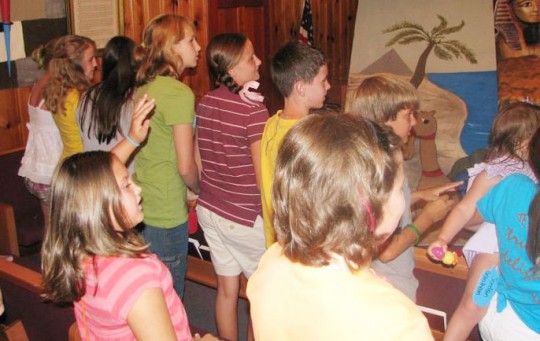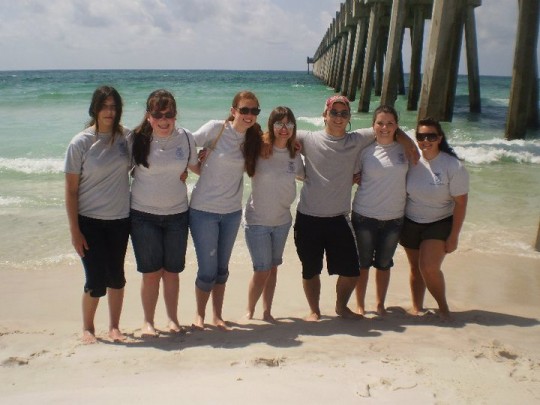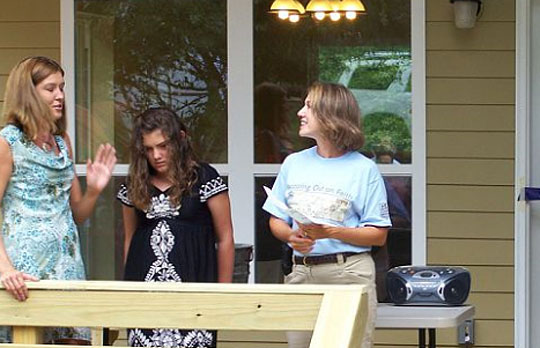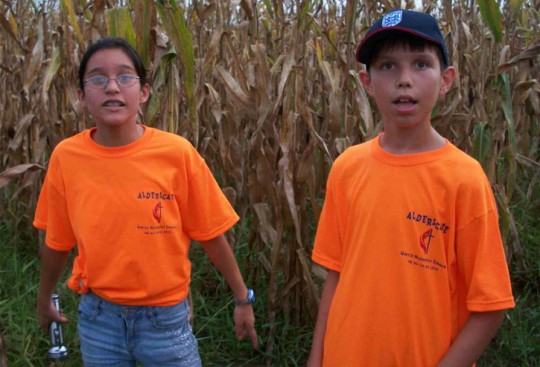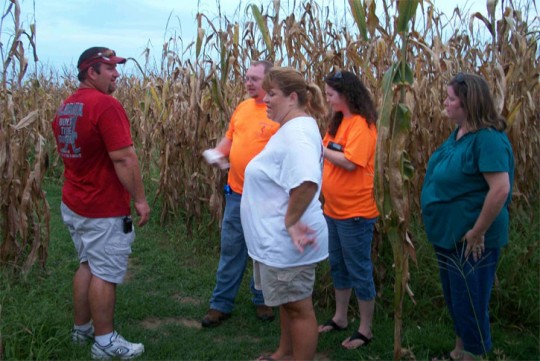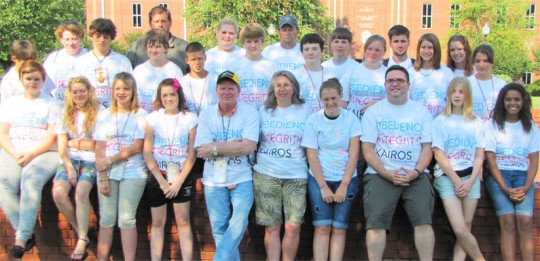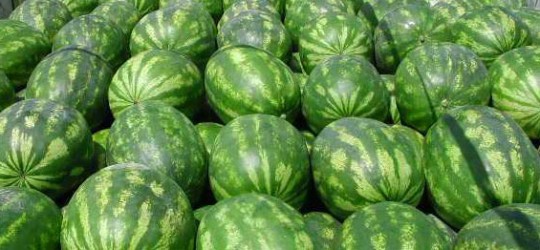Gates, Levins To Wed
July 25, 2010
Jordan Alexandria Gates and Brady Ryan Levins announce their engagement and forthcoming marriage.
The bride-elect is the daughter of Chad and Alison Fournier of Atmore. She is the granddaughter of Billy and Linda Gates of Atmore.
The prospective groom is the son of Dale and Marie Levins of Byrneville, Fla. He is the grandson of Vera Presley of Byrneville and the late Wilson H. Levins and Robert A. Cawthon of Byrneville and Cecilia Morris of Jay, Fla.
Miss Gates is a 2008 graduate of Escambia County High School in Atmore, Ala. She also received an associates degree in science in 2010 at Faulkner State Community College in Bay Minette. She is currently employed by Portrait Innovations in Pensacola as a photographer.
The prospective groom is a 2006 graduate of Northview High School in Bratt. He also completed the law enforcement course at George Stone Criminal Justice Training Center in Pensacola in 2009. He is currently employed by TBH Construction, Inc. in Flomaton.
The couple will exchange vows Saturday, July 31, 2010, at 6 p.m. at the First Baptist Church, Atmore.
Following the ceremony, a reception will be held at the Wisteria in Atmore. All friends and family are invited to attend.
Submitted photo, click to enlarge.
Featured Recipe: ‘Famous’ Special Cheese Lasagna
July 25, 2010
This weekend’s featured recipe from Janet Tharpe is a Lasagna Made “Famous” By Special Cheese Sauce. It’s bursting with a wonder combination of sweet and tangy flavors instead of the normal ricotta cheese filling.
To print today’s “Just a Pinch” recipe column, you can click the image below to load a printable pdf with a recipe card.
Escambia Master Gardeners Tips For July
July 24, 2010
The Escambia County Master Gardeners offer the following tips for July:
YARD
- Plant: Seeds of late cosmos, gaillardia, portulaca, zinnia, marigolds, bulbs, and native iris.
VEGETABLES
- Plant: Seeds of okra, Southern peas, cherry-type tomatoes. Blooms drop if temperature stays high at night, so water regularly and apply at least 3″ of mulch.
- Start: Broccoli, cauliflower, collards and cabbage for fall transplants. Late in the month plant tomato plants rooted from spring suckers or purchased at a garden center. Remember to get the ones marked VFFNT.
MISCELLANEOUS
- Check mulch in flower beds and under trees and shrubs. Reapply to bring it up to three inches to discourage weeds and conserve moisture. Pull mulch back from plant trunks to prevent rot.
- Remove spent vegetable and flower plants. Destroy those infected with disease or insects, and place remainder in compost heap.
- Fertilize annuals early this month if you didn’t do it in June.
- Apply mole cricket bait on moist soil in the afternoon when it is not likely to rain. However, it is essential to read and understand the insecticide label carefully for application directions.
- Keep azaleas and camellias well watered because they are setting next season’s flower buds. Remember that they are shallow rooted. Feed with an azalea fertilizer according to directions, or apply about 1/8 cup of 10-10-10 per foot of plant height after a good rain and water it in.
- Continue to monitor rose bushes each week for signs of insects or disease. Feed regularly with rose fertilizer or use 1/4 cup of 10-10-10 per plant.
- Prune roses late this month or until the middle of August to encourage a good crop of fall flowers. Remove four to six inches of each main stem.
- Lawn pests can be a problem this time of year. Before treating, find out if an insect is the culprit and treat only the affected area.
- Blossom-end rot on tomatoes or similar rot on peppers is frequently caused by a calcium deficiency and fluctuations in soil moisture. Discard rotting fruit. Keep plants evenly moist. Next season have soil tested and amend according to recommendations.
- Watch for yellowing leaves on plants. It may be a sign of chlorosis (iron deficiency), a common condition of sandy soil. Apply liquid iron or minor elements according to label directions.
- Crape myrtles susceptible to powdery mildew should be placed in locations that allow air movement to help avoid potential problems with this unsightly disease.
- Cut back poinsettias, wisteria (cut to two or three buds), chrysanthemums, dahlias and other fall blooming plants to encourage formation of more flowers.
- Pinch off salvia and marigold blooms as soon as they fade. Cut back zinnias, portulacas and verbena by several inches. Feed with 1/4 pound of 10-10-10 per square foot of planted area.
- If you still have blooming cannas, remove flower stalks to right above the uppermost leaf as soon as the blossoms fade. A new flower stalk will sprout.
- Take geranium cuttings for winter color. Start new plants from cuttings or by layering side shoots of oleander, gardenia, abelia, pittosporum, and verbena.
- Time to order cool weather vegetable and flower seeds! Calendula, larkspur, pansies, snapdragons, alyssum, candytuft, dianthus, Shasta daisy, California poppy, gaillardia, baby’s breath, nasturtium, petunias, phlox, verbena, lettuce, radishes, turnips, broccoli, beans, carrots, squash, cucumbers, cauliflower, collards (or milder tasting rape), Swiss chard, and Brussels sprouts. Store seeds in the refrigerator in airtight containers until you are ready to plant.
Photos: Friendship Freewill Baptist Holds Vacation Bible School
July 22, 2010
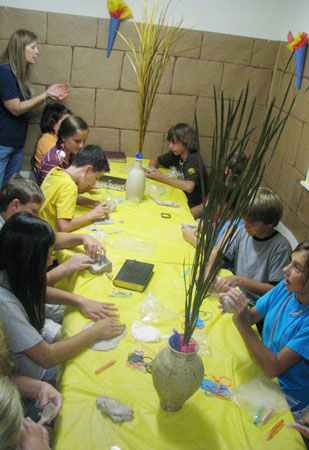 Friendship Freewill Baptist Church near Flomaton is holding their Vacation Bible School this week. VBS continues from 6:30 until 8:30 each evening through Friday. Classes are for ages 3 to 12 and up. The church is located at 1234 Friendship Road.
Friendship Freewill Baptist Church near Flomaton is holding their Vacation Bible School this week. VBS continues from 6:30 until 8:30 each evening through Friday. Classes are for ages 3 to 12 and up. The church is located at 1234 Friendship Road.
Click here for more photos from VBS at Friendship Freewill Baptist in Flomaton.
Submitted photos for NorthEscambia.com, click to enlarge.
Do you have church news or photos to share? Email news@northescambia.com
Giddy Up: Saddle Ridge Ranch VBS Photo Gallery
July 21, 2010
Saddle Ridge Ranch Vacation Bible School is underway this week at Highland Baptist Church on Highway 95A in Molino.
The VBS, for ages Pre-K through graduating fifth graders continues each evening from 5:30 until 8:30 through Friday. There will also be a Family Night Ranch Round-Up with games, a sing-along and a hot dog roast Sunday at 5 p.m.
About 250 took part in the first night of the VBS.
For more photos from the Highland Baptist Church VBS, click here.
Pictured above and below: VBS at Highland Baptist Church in Molino. Photos by Brad Johnson for NorthEscambia.com, click to enlarge..
Do you have new or photos you would like to share from your church? Email news@northescambia.com
Photo Gallery: Northview FFA Officers Attend Leadership Retreat
July 21, 2010
The Northview High School FFA chapter held a leadership retreat Tuesday.
Chapter officers met at Pensacola Beach to learn about the oil spill’s impact on Escambia County from Eric Johnson from the county’s Neighborhood Redevelopment office. They also toured the T.T. Wentworth Museum.
“They took part in several team building exercises and learned what they expect of each other as officers,” said Perry Byars, FFA sponsor.
During the retreat, officers also worked to plan events for the upcoming school year.
Northview High School’s 2010-2011 FFA Officers are: Lydia Weaver, president; Allie Vidak, vice president; Stephanie Solari, secretary; Allyson Bullard, treasurer; Courtney Solari, reporter; Jessica Baldwin, sentinel; and Devin Bell, historian.
Pictures above and below: Officers from the Northview High School FFA during a leadership retreat Tuesday on Pensacola Beach. NorthEscambia.com photos by Lydia Weaver and Allie Vidak, click to enlarge.
Nokomis Habitat Home Dedicated
July 21, 2010
In just two months, an army of volunteers constructed Escambia County Habitat for Humanity’s 17th home.
Construction workers, teachers, bankers, business owners, high school students, ordinary people — over 100 people from all walks of life volunteered their time and skills to make Jennifer Dorriety’s dream of home ownership a reality.
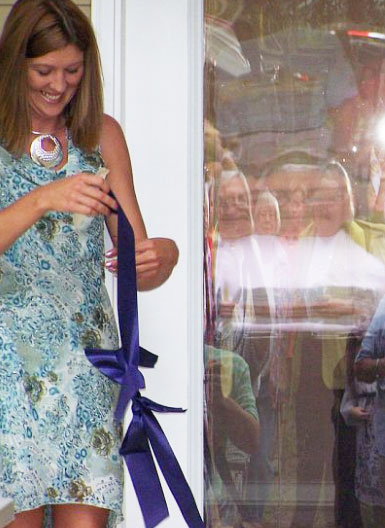 “It’s a dream come true,” Dorriety said recently.
“It’s a dream come true,” Dorriety said recently.
“It’s fun to help and advance the Kingdom of God,” said volunteer Shinora Redmond from Alto Products, one of Habitat’s sponsors for the Nokomis home, as she worked on the first construction weekend back in May.
Many of the volunteers, like Brittany Thompson, 16, had never had in part in building a house.
“I’m here because I wanted to help the people,” said Thompson, one of 14 students from Northview High School that spent part of a May Saturday working on the two bedroom home. “They never had a home of their own, and the home they are living in now is falling apart.”
 Dorriety’s new home, which was dedicated Sunday, will continue to save her money for years to come, said Escambia County Habitat for Humanity Executive Director Alecia Glaize. It incorporates many “green” and sustainable features, like Hardiplank siding, a composite concrete and wood fiber board; bamboo flooring and a long list of energy efficiency features.
Dorriety’s new home, which was dedicated Sunday, will continue to save her money for years to come, said Escambia County Habitat for Humanity Executive Director Alecia Glaize. It incorporates many “green” and sustainable features, like Hardiplank siding, a composite concrete and wood fiber board; bamboo flooring and a long list of energy efficiency features.
Houses constructed by the non-profit Habitat group are not free for recipients like Dorriety. The homes are sold to families at cost — there’s no profit for Habitat. The 20 year mortgages are at zero percent interest, providing much needed savings for those are unable to afford a conventional mortgage. And new homeowners are required to invest 400 “sweat equity” hours working for Habitat.
The Nokomis Habitat build was a change for the group that has constructed 16 homes in Brewton. It’s the first outside of Brewton, the first in a rural area, the first on a raised foundation, and the first on the future homeowner’s land. But it won’t be the last; plans are underway for an additional home near Atmore.
Pictured top: (L-R) Jennifer Dorriety, her daughter Kaylee and Escambia County Habitat for Humanity Executive Director Alecia Glaize at the dedication for Dorriety’s new home in Nokomis. Pictured top inset: Dorriety at Habitat dedication as an army of volunteers and supports (seen in a reflection in the glass) look on. Pictured bottom inset: Volunteers work during the first weekend of construction. Pictured bottom: A group of Northview High School students volunteered to help build the home. NorthEscambia.com and courtesy photos, click to enlarge.
Aldersgate’s A-maize-ing Outing
July 19, 2010
Members of Aldersgate United Methodist Church in Molino recently had an “a-maize-ing” time at “Bratt’s A-maize-ing” cornfield maze. The six acre cornfield maze is located on Highway 4 just west of North Highway 99.
Have news items, announcements or photos from your church? Email them to news@northescambia.com
Submitted photos for NorthEscambia.com, click to enlarge.
Highland 633 Students Attend M-Fuge Camp
July 18, 2010
The Highland Baptist Church 633 Student Ministry recently participated in the M-Fuge Student Camp at North Greenville University in Greenville, South Carolina.
“We took 27 students and adult chaperones. Our students participated each day in ministry projects including children’s ministry, social ministry, games and recreation ministry, painting-cleanup-yard work ministry, and creative ministry. Students were equipped to share their faith, which they did each day. Each day the students and adults participated in worship services and enjoyed various activities as a group. Upon return from camp our students have a renewed heart for serving others in our community with the love of Christ,” said Student Pastor Brad Johnson.
Highland Student Ministry meets each Wednesday night at 6:45pm at Highland Baptist Church, 6240 Hwy 95A North, Molino.
To share news from your church, email news@northescambia.com
Pictured: The Highland Baptist Church 633 Student Ministry at M-Fuge Student Camp in Greenville, South Carolina. Submitted photo for NorthEscambia.com, click to enlarge.
How To Pick That Perfect Summer Watermelon
July 17, 2010
One of the best ways to celebrate summer is to enjoy sweet, ripe watermelons. But knowing when to harvest or buying the best one is not always an easy chore. Of all the hard-to-choose fruits, watermelon is one of the toughest to select. The hard rind of a watermelon can be up to an inch thick and doesn’t soften as it ripens. It’s green when ripe and green when unripe. So, how do you select a juicy, sweet watermelon?
Your best bet is to grow your own or buy local and “in season”, through mid-July. Collin Adcock, Extension Agent in Washington County, provides us some tips on how to know when to harvest watermelons from your garden.
 Choosing a ripe watermelon from the field or garden can be much easier than choosing a ripe one in the store. The ability to recognize a ripe melon comes from years of experience and careful observation. In the garden there are several clues to help determine the ripeness of a melon that one does not always have in the store.
Choosing a ripe watermelon from the field or garden can be much easier than choosing a ripe one in the store. The ability to recognize a ripe melon comes from years of experience and careful observation. In the garden there are several clues to help determine the ripeness of a melon that one does not always have in the store.
Most people rely on four methods of determining melon ripeness in the field.
First, look at the tendril or “pigtail” closest to the melon. When this tendril turns brown and dries out, it is a good sign that the melon is ripe.
Next, look at the bottom of the melon where it lays on the ground. When this area, sometimes referred to as the “color spot”, turns from white to a light yellow, there is a good chance the watermelon is ripe.
 Then look at the rind. When the rind becomes rough to the touch and turns from a more shiny color to a more dull color and is resistant to penetration by the thumbnail it is a sign of melon ripeness.
Then look at the rind. When the rind becomes rough to the touch and turns from a more shiny color to a more dull color and is resistant to penetration by the thumbnail it is a sign of melon ripeness.
The last method is the thump test. This is done by thumping the top of the melon. If the watermelon has a dull thud when thumped, it is very possible the melon is ripe. Unripe melons will usually have a tighter, ringing or hollow sound. Be careful when using this test because it is not always reliable. Watermelons do not always give off a dull thud when ripe. For some watermelons a dull thud may indicate an over-ripe melon.
Only a melon’s taste can provide definitive proof as to its ripeness. A foolproof approach is to cut open several melons that appear to be ripe (based on the above methods), and then taste all of the melons and decide which one has the best taste. After locating the best tasting watermelon note the condition of the closest tendril, the color spot, how the thump sounds, and the shine of the rind along with melon size. Harvest all those that have similar characteristics.
When buying a watermelon, you should look for “a firm, symmetrical watermelon that is free of bruises, cuts or dents” according to the National Watermelon Promotion Board.
When you see a nice-looking watermelon, pick it up and feel its heft; then pick up a few others of similar size to compare. At 92 percent water, a good melon should feel heavy for its size.
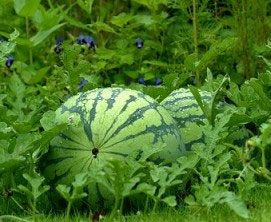 How do you know a watermelon ripened on the vine? Easy, turn the melon over and check for a creamy yellow spot. That’s a sign that the watermelon sat on the ground and in the sun to ripen. The yellow spot is the only place the sun didn’t hit.
How do you know a watermelon ripened on the vine? Easy, turn the melon over and check for a creamy yellow spot. That’s a sign that the watermelon sat on the ground and in the sun to ripen. The yellow spot is the only place the sun didn’t hit.
Theresa Friday is the Residential Horticulture Extension Agent for Santa Rosa County.




